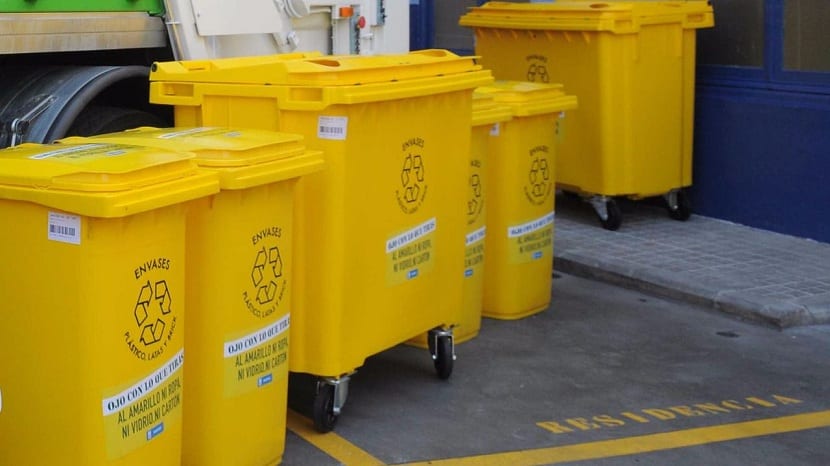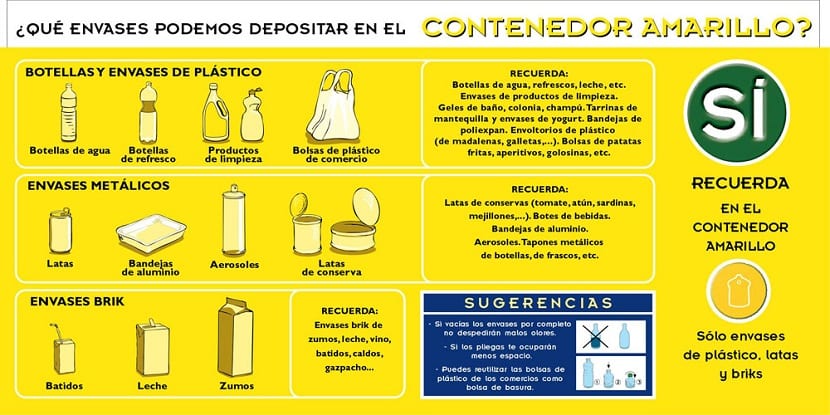
El yellow container recycling is one of those that generates the most doubts as to what waste to deposit. There are many occasions that we have a type of container in our hands that creates certain doubts about whether to throw them into the yellow container or it has to be deposited in another. In addition, there are various curiosities about this type of container and a recycling process that, if the selective prior separation is done well, a lot of material can be used.
We are going to show you what you should throw into the yellow container to clear up your doubts and what is the recycling process for them.
What to put in the yellow container

There are many doubts that arise about waste. Not only in this container but in the rest. They tell us in a general way the types of waste that we have to throw into each container. However, only the most superficial materials tell us regardless of the state of the waste at the time of dumping. This is what creates doubts about what things can be recycled.
The yellow container has been operating in Spain for more than 20 years. For every 117 inhabitants on average we find a container. This is how we can increase the rate of recycling of materials since there is a greater selective separation. Each year the number of recycled plastics, bricks and cans per inhabitant increases. However, more than a third of the population still does not know where to deposit each type of waste.
Among the most common waste that we must deposit in the yellow container we have the Plastic bottles, all plastic and metal containers (such as aerosols, cans, aluminum trays, deodorant cans, etc.), juice bricks, milk or soups and more. That waste that workers find in the treatment plant and that should not go in this container are called improper.
Errors that are made

It is very difficult to have a complete knowledge of the waste that goes in each container without having a fault. Either you are one of those who is dedicated to recycling and the environment or surely there is a fault in the middle of the process. And that there are different types of materials composed of various components that make you doubt. For example, cardboard ice cream tubs look like sturdy plastic boxes and they should go into the yellow container. There is also doubt about the condition of the product, since many packages have some food scraps stuck to the sides. It is impossible to stop to wash or scrub a residue that you are going to throw away. We would waste water and we would end up wasting a more precious asset.
Among the most common errors of improper waste in this type of container we find: plastic toys. It is obvious that if a toy is made of plastic we think that it is recycled in the yellow container. However, for this type of material there is an exclusive container or it can be taken to clean point or we can also donate them to associations that are responsible for distributing them to those most in need. Another mistake is bottles and pacifiers, kitchen utensils and plastic buckets. All this waste goes to the waste container.
Between the types of containers There is a wide variety of waste, which makes recycling difficult. In addition, sometimes you have to take into account the recycling symbols to better understand the composition of the product.
Other materials known as inappropriate are coffee shop paper cups, laminated paper used in butcher shops, tupperware, aluminum coffee capsules, thermoses, plastic flower pots, CD and DVD cases and VHS video cassettes.
Curiosities about recycling

In order to better visualize the usefulness of selectively separating for later recycling, we are going to show you some results. With just 6 juice bricks you can make a shoe box. 40 plastic bottles turn into a fleece liner. 80 soda cans become a bicycle tire. 8 canning jars can be used to create a cooking pot. With 22 plastic bottles you can make a T-shirt and with 550 cans a chair.
These are just a few examples of abundant waste that can be turned into other products having a new life. Using waste as raw material we are saving a large amount of materials and, therefore, more amount of energy and pollution that we are emitting into the atmosphere.
These actions have a positive aspect in the fight against climate change and environmental pollution. By recycling 6 cans or bricks we will be counteracting the gases emitted by an exhaust pipe for 10 minutes. You have to learn to contribute for a good cause and use waste as new products.
Recycling process
For many people the recycling process ends when the waste is deposited in the container. However, this is only the beginning of the journey. The containers poured into the yellow container go to a sorting plant where they undergo a process that consists of:
- Separation of materials that are suitable and those that are unsuitable. Materials are separated into fractions such as metals, steels, aluminum and plastics.
- They segregate them according to the colors to optimize the use of colorants in new products.
- The pieces are broken until they are crushed into small pieces for their better treatment and they are washed to remove impurities. The pieces are washed with water, therefore, it is not necessary for the containers with the rest of the food to be completely cleaned.
- Dries and spins to remove any impurities that may have remained after washing.
- The mixture is homogenized to have a uniform texture and color and to be able to generate products with that color and texture.
- Materials are re-purified to remove more impurities and start generating the desired new products from the remnants of the old ones.
I hope that with this information you can learn more about the waste that is deposited in the yellow container.
